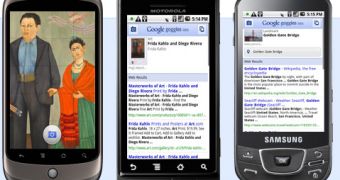Online search keeps getting better and better, but it’s starting to become clear that search as we know and understand it today has some big, inherent limitations. In the first decade of this millennium, the web was defined by search and it still is one of the biggest things online. Google search is the most visited site in the world after all. But its importance is declining, not because people don’t need to find things anymore, because the current tools can’t really cope with the increasingly complex needs any longer.
One thing that promises to revolutionize the field, in the long term at least, is visual search. It’s very much in the early days, but the simple fact that tools like Google Goggles even exist shouldn't be underestimated. The visual search tool for mobile phones from Google would have been something out of SF movies even five years ago. And Google thinks it has a long way to go yet.
In an interview with Techradar, Goggles’ Product Manager, Shailesh Nalawadi, has talked about the current state of the technology and what its future may hold. For now, Google Goggles can identify millions of objects from camera-phone pictures. Just point your smartphone at something and the tool will try to retrieve as much information on it as possible.
It works for things like books and paintings and other relatively easily identifiable ones. It should be even better at these types of things in the future, as Google has just acquired Plink, a company specialized in visual search. It also does text recognition and it even works for popular landmarks, allowing you to get easy access to more information on them. But Google says this is just scratching the surface.
"We struggled and we built this thing where you can move your camera, point it at an object and have it come back and tell you what it is that it's looking at. The reality is we're really far from that state," Nalawadi says. Identifying businesses and books is one thing, identifying anything that you may come across in your daily life is quite another.
"Primarily, it's about extending the recognition capabilities of our computers. Right now we have a very narrow set of tens of millions of objects that we recognise but the world is much larger than tens of millions of objects and it's a phenomenal effort to try and get this info into our database and recognise it," he adds.
The next step is to recognize things like plants and, for some reason, chess moves. Point your phone at a chess board and it will help you with possible moves. Beyond that, any object in the world, within reason, should be, at one point, recognizable by Google Goggles. Another interesting piece of info is that Google plans to open up the platform in the future. Right now, Google doesn’t really know what developers would come up with and what functionality they’d want access to. But when Google does feel ready to release a Goggles API, you can expect some very exciting apps built on it.

 14 DAY TRIAL //
14 DAY TRIAL //